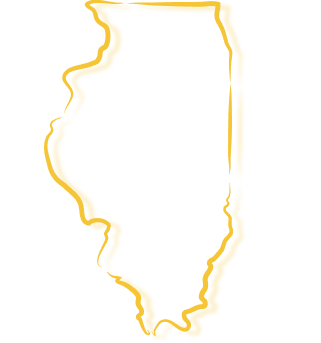Dangerous Intersections in St. Louis

By Zane T. Cagle | February 11, 2019 | Car Accidents
Take Great Care When Driving in These Locations
Statistics indicate that traffic crashes in Missouri caused 766 deaths, 47,977 injuries, and property damage to more than 103,000 vehicles in a single year. While crashes can occur almost anywhere, they occur far more frequently at intersections. Whether you drive a car through an intersection, ride a bike, or cross at a crosswalk, you must always understand the risks of intersection accidents and injuries.
The Missouri State Highway Patrol published information regarding accident reports across Missouri including St. Louis County and some St. Louis City including where the accident location. From this information (and from experience driving around St. Louis), we can surmise some of the most dangerous intersections around the greater metropolitan area that see a higher frequency of crashes for a variety of reasons.
Grand Boulevard and Interstate 64
The exit for Grand Boulevard from I-64 in the city of St. Louis takes you right into Midtown. The most prominent feature of this area is St. Louis University, with most of its campus to the north and its medical school to the south of the exit. Just north of the SLU main campus, Grand Boulevard takes you right into the major arts district of St. Louis, which includes the Fabulous Fox Theatre, Powell Symphony Hall, and Jazz on the Bistro. People also regularly take Grand to reach the Sheldon Concert Hall and the Contemporary Art Museum of St. Louis. Numerous restaurants and bars, as well as many loft and apartment complexes, populate the area.
Needless to say, an endless stream of cars both exit and enter I-64 from Grand. However, the city nor state has redesigned or renovated these exits in decades, and the exit ramp to head north on Grand may be particularly dangerous. With a sharp curve, cars must suddenly hit the brakes to stay on the ramp and avoid hitting other cars (reducing speed at entrance and exit ramps is important) The wide intersections on Grand over the highway can also be confusing, as they also involve the major roadway of Forest Park Avenue. All of the above conditions may have contributed to the increased number of accidents at Grand Boulevard and I-64, making it one of the most dangerous intersections in the entire St. Louis area.
Delmar Boulevard and Skinker Boulevard
Delmar Boulevard in University City is famous for the Loop neighborhood, which has numerous concert venues, restaurants, bars, boutiques, and coffee shops. This section of Delmar is almost always bustling with traffic, pedestrians, bicyclists, and even the new streetcar.
One of the major intersections in this area is Delmar and Skinker Boulevard. Skinker is a major thoroughfare with entrances into the beautiful Forest Park on one side and Washington University on the other. With the traffic in and out of the park, students driving and walking to and from school, and visitors to the Loop, it should surprise nobody that Delmar and Skinker is one of the most dangerous intersections in St. Louis. If you frequent this area, you have seen ambulances, police cars and damaged vehicles at this location and thus is a warning to take care when driving in this area and always know what to do if an accident does occur.
Arsenal Street and McCausland Avenue
Not too many streets serve as east-west corridors between the major north-south roads in South St. Louis. One such street is Arsenal, which starts at McCausland and goes all the way to Seventh Street downtown. For this reason, Arsenal is a popular road to travel for people coming from Maplewood and nearby areas in St. Louis County who are heading to the eastern parts of South City. Another popular roadway in the southern part of the city is Interstate 44, which thousands of commuters use on a daily basis. One of the most used on-ramps to I-44 east is located on Arsenal Street just after you turn from McCausland Avenue.
For the above reasons, the intersection of Arsenal and McCausland is busy. In addition, traffic tends to back up along McCausland, with people waiting to turn onto Arsenal during busy times of the day. This all too often leads to drivers trying to avoid waiting through another light cycle by running the red light or making a dangerously close left turn. Not surprisingly, the intersection of Arsenal and McCausland is commonly known as one of the most dangerous intersections in the St. Louis area.
McKnight Road and Interstate 64
Ladue is a desirable suburb in which to live in the greater St. Louis metropolitan area. However, even in the nicest neighborhoods, traffic problems and car accidents occur. When suburbs are newer, we tend to think the traffic design is better, but that is not always the case and increased traffic can contribute to crashes. Ladue contains a few hotbeds for car accidents and injuries. One such intersection is at McKnight Road and Interstate 64.
From I-64, McKnight heads north to Ladue Road, and after a short break, connects Delmar to Olive Boulevard. The road also heads south until it turns into Rock Hill Road at Manchester. One of the highlights of McKnight is Tilles Park. Tilles Park has ball fields, a fishing pond, running paths, and plenty of green space, and it is also the home of the famed Winter Wonderland holiday lights display. This causes a backup of traffic on McKnight on almost a nightly basis and traffic, in fact, sometimes backs up onto the interstate itself.
Coming north on McKnight, motorists may find a confusing signal at which northbound traffic must stop but no one else does. All of these circumstances create elevated risks of accidents at this intersection. Drivers must pay close attention to this intersection as it is one of the most dangerous intersections in St. Louis.
Hampton Avenue and Oakland Avenue
When you think of dangerous intersections, you may first think of the crossing of a primary corridor with a major interstate. You may not think of an intersection involving a relatively short and lesser-used avenue. However, while Oakland Avenue only briefly connects McCausland with Kingshighway Boulevard, the location where it passes through Hampton Avenue is particularly dangerous.
Much traffic passes through this area, with drivers both getting on and off Interstate 64 and trying to enter Forest Park at the Hampton entrance for access to the zoo and art museum. In addition, the traffic signals can confuse drivers at Oakland, as motorists exiting the highway are unsure whether they must stop and may not see the white line for stopping unless they are paying close attention. As a result of the traffic and possible poor road design, this is one of the most dangerous intersections in St. Louis. Crashes do occur frequently at this intersection and drivers must be on high alert at every traffic light and intersection.
Old State Road and Missouri Route 100
Route 100 in Missouri is a 121-mile long east-west thoroughfare better known as Manchester Road. As one of the major roadways in the St. Louis area, Manchester was part of the Lewis and Clark Trail and once part of the historic Route 66. It is also widely used in the western parts of St. Louis County such as Wildwood and Ellisville.
One highly dangerous intersection on Route 100 is with Old State Road. Old State Road contains many different residential neighborhoods and also connects Manchester with Highway 109, which is commonly used to get to Eureka and Interstate 44. Old State Road, however, winds, and people often speed, making the road itself fairly dangerous.
Motorists often travel through this intersection without realizing the high number of accidents at this intersection. Failing to observe a traffic signal in a high traffic area can be disastrous. As a driver, you must take note of other cars around you, drive focused and avoid risky driving behaviors such as trying to beat a yellow light.
Defensive driving is usually the best policy in heavy traffic and high crash-risk intersections. Be patient, follow the rules of the road and pay attention. Sometimes the patience means waiting through another light cycle in heavy traffic delaying you a few minutes. However, patience and safety may be the difference between a crash or arriving at your destination safely.
Ladue Road and Interstate 170
Interstate 170, commonly called the Inner Belt Expressway by St. Louisans, is a short highway that runs from I-64 to I-270. Many different exits and entrances onto I-170 lead to a busy section of Brentwood, downtown Clayton, and the airport. One of the perhaps less prominent exits is onto Ladue Road, in the heart of the Ladue suburb. However, do not overlook this intersection, as it ranks as one of the most dangerous intersections in the St. Louis metropolitan area.
When you get off the highway at Ladue, you can go west into a residential area, east into Clayton, or north into a popular shopping area with a Barnes & Noble, Old Navy, grocery stores and boutiques. No matter which direction you go, however, you run a high risk of a traffic collision at this location. Weekend and holiday traffic make this a busy intersection as well as during the morning and evening commutes. Again, multiple crashes have occurred at this busy intersection over the years.
Grand Boulevard and Lindell Boulevard
As mentioned above, Saint Louis University is a major feature of the Midtown area of St. Louis City. The university takes up several city blocks. More than 13,500 undergraduate and graduate students attend, many of whom also live and work in Midtown. Like many college campuses, walking and bicycling is a major form of transportation for many students. However, certain areas of the SLU campus are also known for their traffic congestion. Grand Boulevard cuts directly through the SLU campus and meets Lindell Boulevard on the north end of the university. The intersection has a constant stream of pedestrians, which can hold up traffic even more and confuse drivers as to who has the right-of-way. Pedestrians have the right-of-way with the light. Pedestrians must pay close attention to only cross in the crosswalks at these intersections. Drivers have to pay close attention and slow down realizing that there is so much foot and cycle traffic. Additionally, the number of scooters have greatly increased in this area. While drivers of scooters are not supposed to operate as pedestrians, many use the sidewalks instead of the streets. Certainly, there is a learning curve happening with scooter use and all drivers must be on the lookout for all people on the roadway and crosswalks.
This part of Grand also leads to a popular arts district of St. Louis, including the Fabulous Fox Theater and Powell Symphony Hall, as well as jazz bars and restaurants. On show nights, there is heavy traffic on Grand and it can feel like a parking lot. In this congestion, some drivers may fail to stop for pedestrians or may run red lights. Overall, it should surprise nobody that the intersection of Grand and Lindell Boulevards is one of the most dangerous intersections in the St. Louis metropolitan area.
Accidents Can Happen Anywhere
Even though the above intersections are particularly dangerous, accidents and injuries can happen anywhere in the St. Louis metropolitan area. You can drive a route you’ve driven thousands of times before when a negligent driver suddenly crashes into you and disrupts your life. You should always know what to do following an accident, including:
- If possible, move your car out of the intersection to a safe place. If that’s not possible, and your injuries allow it, exit your car and wait off the road.
- If you believe you suffered injuries, get medical attention right away. You should undergo a proper examination both to receive the treatment you need and to create a record of your accident-related injuries.
- Call a car accident lawyer as soon as you can. Our attorneys can help with every step of your insurance claim or personal injury lawsuit to fight for the full compensation you deserve.
Contact Our St. Louis Accident and Injury Attorneys for Free Today
The Cagle Law Firm helps accident victims throughout the St. Louis area and in Illinois. We know how to fight for your rights after a serious injury, so please contact us online or call (314) 391-5220 for your free consultation as soon as possible.
Contact Us Today
The Cagle Law Firm serves accident and injury clients throughout St. Louis and the greater St. Louis metro area, including St. Louis Counties of Chesterfield, Wildwood, Eureka, Ladue, Olivette, Clayton, Kirkwood, Fenton, Affton, and Jefferson Counties of Arnold, High Ridge, Antonia, House Springs, and the eastern Missouri and southern Illinois communities. If you or your family needs legal assistance with your personal injury case, call The Cagle Law Firm at (314) 276-1681 or use our online contact form to request a free case review or get more information.
Areas Served
The Cagle Law Firm – Missouri
The Cagle Law Firm – Illinois
The Cagle Law Firm – Kentucky
CONTACT THE CAGLE LAW FIRM TODAY
Request your FREE CASE REVIEW today by calling (314) 276-1681 or by sending a message through the site contact form. Your contact info stays private and is only used to reply to your inquiry.
Whether you need information about a new injury or existing injury, our lawyers answer your questions with no-risk and no followup marketing.
Free Consultations and Case Reviews
Questions? Ask An Attorney
Fields marked with an * are required
Copyright © 2025 St. Louis Personal Injury Lawyers | The Cagle Law Firm. All rights reserved.
Disclaimer | Site Map | Privacy Policy
Get a free case review with St. Louis' best personal injury lawyers to help you win top compensation





